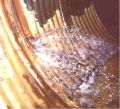Go-Pro Mounted on a Sled: Difference between revisions
(Created page with "<div style= "text-align:center;">''Message: Using a mobile video camera mounted on a sled is a cost effective method to inspect straight conduits.''</div> ----</br> Using a mobile video camera, such as a GoPro®, mounted on a sled is a cost effective method to inspect straight (without bends or undulations) conduits, especially conduits at remote dam sites given its small size and ease of transport. The sled can be easily manufactured and attached to a metal push pipe w...") |
No edit summary |
||
| (One intermediate revision by the same user not shown) | |||
| Line 1: | Line 1: | ||
[[Category:Existing Conditions Outlet Works]] | |||
---- | |||
''' ''Message: Using a mobile video camera mounted on a sled is a cost effective method to inspect straight conduits.'' ''' | |||
Using a mobile video camera, such as a GoPro®, mounted on a sled is a cost effective method to inspect straight (without bends or undulations) conduits, especially conduits at remote dam sites given its small size and ease of transport. The sled can be easily manufactured and attached to a metal push pipe with couplers to extend the sled in 6-foot lengths, as necessary. This style of system will allow the conduit to be inspected by providing video and pictures, but has limitations associated with the lack of panning capabilities and maneuverability of the camera. | Using a mobile video camera, such as a GoPro®, mounted on a sled is a cost effective method to inspect straight (without bends or undulations) conduits, especially conduits at remote dam sites given its small size and ease of transport. The sled can be easily manufactured and attached to a metal push pipe with couplers to extend the sled in 6-foot lengths, as necessary. This style of system will allow the conduit to be inspected by providing video and pictures, but has limitations associated with the lack of panning capabilities and maneuverability of the camera. | ||
| Line 10: | Line 11: | ||
File:GPM4.jpg|Dam Safety Program Inspection Sled with Still Camera (MT DNRC). | File:GPM4.jpg|Dam Safety Program Inspection Sled with Still Camera (MT DNRC). | ||
File:GPM5.jpg|Dam Safety Program Inspection Sled with Still Camera (MT DNRC). | File:GPM5.jpg|Dam Safety Program Inspection Sled with Still Camera (MT DNRC). | ||
File:GPM6.jpg|Settlement in conduit causing ponding of water at invert (FEMA). | File:GPM6.jpg|[[Settlement]] in conduit causing ponding of water at invert (FEMA). | ||
File:GPM7.jpg|Photo showing joint separations in CMP (U.S. Department of Transportation). | File:GPM7.jpg|Photo showing joint separations in CMP (U.S. Department of Transportation). | ||
File:GPM8.jpg|Photo of water leaking into CMP conduit. | File:GPM8.jpg|Photo of water leaking into CMP conduit. | ||
| Line 16: | Line 17: | ||
</gallery> | </gallery> | ||
''Note: The content on this page was originally created as part of DamOutletWorks.org (DOWL, 2018). It has subsequently been updated and reformatted as part of the Dam Safety Toolbox.'' | |||
[[Category:Example Pages]] | [[Category:Example Pages]] | ||
{{Revhistinf}} | {{Revhistinf}} | ||
Latest revision as of 00:24, 2 December 2022
Message: Using a mobile video camera mounted on a sled is a cost effective method to inspect straight conduits.
Using a mobile video camera, such as a GoPro®, mounted on a sled is a cost effective method to inspect straight (without bends or undulations) conduits, especially conduits at remote dam sites given its small size and ease of transport. The sled can be easily manufactured and attached to a metal push pipe with couplers to extend the sled in 6-foot lengths, as necessary. This style of system will allow the conduit to be inspected by providing video and pictures, but has limitations associated with the lack of panning capabilities and maneuverability of the camera.
Note: The content on this page was originally created as part of DamOutletWorks.org (DOWL, 2018). It has subsequently been updated and reformatted as part of the Dam Safety Toolbox.
Revision ID: 4694
Revision Date: 12/02/2022








